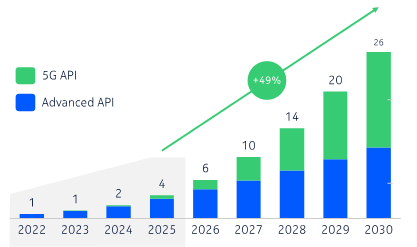The transformative power of network APIs
For decades, telecommunication companies operated within closed networks, tightly controlling access to infrastructure details. They prioritized providing connectivity while keeping network complexities hidden. This approach positioned them as guardians of the telecom ecosystem. However, with technological advancements and changing consumer demands, this model has become increasingly unsustainable. Application developers have been restricted by limited access to network internals, hampering innovation. This has sparked a push for greater openness in the telecommunications industry, recognizing the necessity for change. #Sponsored

The emergence of ecosystems
The emergence of software-based networking standards, particularly 5G, has spurred a paradigm shift toward ecosystems. Telecommunication companies are recognizing that sustaining closed networks is increasingly untenable in an age characterized by digital transformation and a growing appetite for innovative solutions. Embracing ecosystems unleashes a multitude of opportunities, enabling stakeholders to collaborate, innovate, and explore new use cases and functionalities.
Such an ecosystem model has already been proven with a very limited set of communications APIs called Communication Platform as a Service (CPaaS), which provide developers with access to voice, text (SMS and MMS), video, email, and authentication services embedded into the networks of communications service providers.
However, CPaaS falls short of meeting the dynamic needs of developers who seek to harness a broader array of network capabilities. The limitations of CPaaS, often cantered around a restricted scope of communication services APIs, impede developers from realizing the true potential of network capabilities.
Dawn of the advanced network APIs
In 2023, the telecoms industry demonstrated an unprecedented commitment to openness with the introduction of the GSMA Open Gateway initiative and the increasing popularity of the CAMARA project. All stakeholders in this dynamic ecosystem stand to benefit: CSPs expand developer access to their network attributes, developers innovate novel application experiences, and enterprises unveil exciting products and services. This collaboration empowers CSPs to fully harness the potential of their network through strategic partnerships with application developers, paving the way for pioneering Industry 4.0 and consumer use cases.

Taken from a study conducted by Analysys Mason in 2023
Several examples illustrate these use cases. For instance, consider beyond visual line of sight (BVLS) drones operated remotely by individuals hundreds of kilometres away. As the drone traverses’ various terrains, it requires different network capabilities to adapt to unique conditions encountered along its journey. In another scenario, Liberty Global, through Telenet’s 5G standalone network with slicing capabilities, enables remote captains to operate vessels safely and efficiently, leveraging real-time data provided by ultra-low latency network capabilities and zero-touch automation. These are just two of countless potential use cases. Network APIs hold the potential to drive innovation in industrial robotics, real-time streaming of immersive video using multiple cameras, latency-sensitive applications such as VR and cloud gaming, and much more.
The shared value model
The transition toward ecosystems heralds a new era of opportunity for CSPs, positioning them at the forefront of innovation and collaboration within the ecosystem. While the benefits of network openness are often lauded by application developers, CSPs stand to gain significantly from this paradigm shift.
By embracing a revenue-sharing usage model, CSPs can leverage their network assets beyond basic connectivity, unlocking new avenues for revenue generation and market differentiation. This innovative approach not only enables CSPs to monetize their infrastructure more effectively but also fosters a culture of partnership and shared success within the industry.
Furthermore, the adoption of network openness empowers CSPs to engage in collaborative ventures with developers, enterprises, and other stakeholders, driving mutual growth and innovation. By providing access to their network capabilities through user-friendly APIs and software tools, CSPs can catalyze the development of innovative applications and services that enhance customer experiences and create new revenue streams.
Moreover, the shared value proposition inherent in network openness aligns the interests of stakeholders across the telecommunications industry, paving the way for sustainable growth and development. By embracing this collaborative ethos, CSPs can position themselves as key enablers of digital transformation, driving value creation and competitive advantage in an increasingly dynamic marketplace.
Conclusion
This year marks the opportune moment for embarking on real-world applications tailored for authentic customers, bolstered by genuine platforms and ecosystem collaborators. The potential for network APIs extends beyond the limits of CPaaS; therefore, it’s imperative to adopt a commercial strategy that steers clear of a replication of the past CPaaS scenario. By harnessing the inherent opportunities of network openness, CSPs can position themselves as pioneers of digital transformation, driving growth, differentiation and value in an increasingly competitive landscape. Through strategic alliances, innovative commercial frameworks and an unwavering dedication to customer-centric practices, CSPs can adeptly navigate challenges and capitalize on the potential of network openness, thereby shaping the telecommunications landscape for years to come.
About the Author(s)
You May Also Like





_International_Software_Products.jpeg?width=300&auto=webp&quality=80&disable=upscale)







